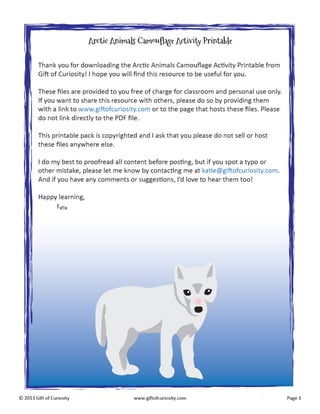Test Title
0 likes204 views
Many arctic animals change color from brown in the summer to white in the winter as a camouflage mechanism to blend in with their surroundings and avoid predation. The document discusses an activity where children look at pictures of arctic animals like snowy owls and arctic foxes in different seasons and place cut-out pictures of the animals on summer and winter backgrounds to see how their brown or white fur helps them blend in depending on if there is snow on the ground.
1 of 3
Download to read offline



Recommended
New widget



New widgetBhavani Testone
Ėý
This document provides instructions for using the manual for a Samsung mobile device. It describes the various parts of the device, including keys and ports. It provides step-by-step guides for assembling the device by inserting the SIM card and battery, charging the battery, and inserting an optional memory card. It also includes safety warnings and copyright information.Word- outbound



Word- outboundBhavani Testone
Ėý
Teks ini berisi serangkaian kalimat Lorem Ipsum yang menjelaskan tentang adipiscing elit dan diam nonummy nibh serta menyatakan bahwa dokumen ini hanya uji coba dan tidak boleh digunakan kecuali untuk lingkungan pengujian saat ini.Fluentlenium Functional tests hang.pdf



Fluentlenium Functional tests hang.pdfBhavani Testone
Ėý
The test hangs when trying to navigate to a URL using Fluentlenium in Firefox. Switching to HtmlUnit also results in a hang on a specific page. Angular.js is suspected to be the cause of the issue. Updating Selenium and jQuery resolved the problem, with jQuery 1.9.0 found to be incompatible and downgrading to 1.8.3 fixing the hang.format.txt.txt



format.txt.txtBhavani Testone
Ėý
19 elite firefighters known as "hotshots" were killed while battling a wildfire in Yarnell, Arizona, marking the deadliest wildfire involving firefighters in at least 30 years. The firefighters were forced to deploy emergency fire shelters when flames overtook them near the town. The deceased firefighters were part of the Prescott Fire department.Presentation



PresentationBhavani Testone
Ėý
19 elite firefighters known as "hotshots" were killed while battling a wildfire in Yarnell, Arizona, marking the deadliest wildfire involving firefighters in at least 30 years. The firefighters were forced to deploy emergency fire shelters when strong winds caused the fire to change direction near the town. The deceased firefighters were part of the Prescott Fire department.Diet Plan.pdf



Diet Plan.pdfBhavani Testone
Ėý
This document provides sample diet plans for days 1-3 of the GM diet, which is intended to help lose 8 kg of weight in 7 days. Day 1 involves eating fruits like apples, papaya, watermelon, and oranges along with water and coconut water. Day 2 replaces breakfast with boiled potato and has meals of cabbage, tomatoes, and steamed vegetables and water. Day 3 continues with fruits like apples, melon, mango and vegetables like cucumber, lettuce, tomato and beet in strict combination with water intake.good one
cloning the message



good one
cloning the messageBhavani Testone
Ėý
The document provides tips and suggestions for creating effective presentation slides, including:
- Using few words on each slide and letting pictures convey information
- Avoiding distracting backgrounds and fonts that are hard to read
- Explaining any graphics or animations used
- Practicing the presentation to avoid filler words and ensure proper timing
It also warns against common pitfalls like reading the slides verbatim, having too much text on slides, or flipping between slides without explanation.03DOM.ppt



03DOM.pptBhavani Testone
Ėý
The document provides an overview of the Document Object Model (DOM) and how JavaScript can be used to manipulate the DOM. It discusses how the DOM used to be browser-specific but is now a standard that can be manipulated by various languages. It provides examples of DOM tree structure, referencing DOM objects by ID, and manipulating DOM properties like innerHTML and visibility. The document is intended as a tutorial for learning the DOM and JavaScript DOM manipulation.Std10-Maths-EM-1.pdf



Std10-Maths-EM-1.pdfBhavani Testone
Ėý
This document is the preface to a mathematics textbook for 10th standard students in Tamil Nadu, India. It outlines the goals of revising the textbook to implement a uniform curriculum across all school streams and improve mathematics education. It emphasizes that mathematics is essential for science, technology, and individual growth. The preface notes that the textbook aims to help students grasp fundamentals and apply them to problem solving. It also stresses the importance of the teacher's role in guiding students and making learning learner-centered. The textbook contents are arranged logically with examples to provide practice for thorough understanding.http---cdata.nqa.sprinklr.com-DAM-5-2010blast-100530124747-Blast-cc20d154-5e0...



http---cdata.nqa.sprinklr.com-DAM-5-2010blast-100530124747-Blast-cc20d154-5e0...Bhavani Testone
Ėý
BLAST is a novel presentation format that encourages rapid knowledge transfer through short slides of 8 words or less to avoid "death by powerpoint". It aims to efficiently convey key information in a brief format. The presentation and additional references on the BLAST format can be found at blast.emcrit.org.Tales-29th



Tales-29thBhavani Testone
Ėý
This collection of fairy tales promises to transport readers to fantastical worlds full of old-world charm and mysticism. It includes many free tales for kids, with pictures, from KidsGen which aims to be a top site for new age children. The stories are meant to allow readers to lose themselves in far away fantasies and feel nostalgia.New text document-29th



New text document-29thBhavani Testone
Ėý
A queen was told by a fairy that her daughter would bring her woe, so she attached a hawthorn branch to the newborn princess's head, turning her into a monkey. The monkey was raised by the queen's nephew but later captured by monkey king Magot who wanted to marry her. She refused and fled, transforming back into a princess after opening a magic chest. She fell in love with her cousin, but was imprisoned by the fairy. He rescued her and they married, reconciling their kingdoms.uPoGPpb.ppt



uPoGPpb.pptBhavani Testone
Ėý
This document provides an overview of commonly used features in PowerPoint. It demonstrates how to add and format slides, apply themes, vary text formatting, insert images from clipart or files, add animated and timed text, apply slide transitions and sounds, use shapes and diagrams, embed videos, add action buttons for navigation, and link to web content and email addresses. The goal is to serve as both a user guide and example presentation to learn PowerPoint features.Reporting & Analytics.pdf



Reporting & Analytics.pdfBhavani Testone
Ėý
The document provides an overview of reporting and analytics capabilities in Sprinklr. It describes navigating between standard dashboards, setting filters and date ranges, and customizing dashboards. Standard dashboards track metrics like campaigns, social engagement, inbound/outbound tags, and service level agreements. Custom dashboards can be created and shared with other users. The document contains step-by-step instructions for using various reporting features in Sprinklr.Tales



TalesBhavani Testone
Ėý
This collection of fairy tales promises to transport readers to fantastical worlds with old-world charm and mysticism. It includes many free tales for kids, with pictures, from KidsGen which aims to be a top site for new age kids to enjoy stories and lose themselves in far away fantasies or feel nostalgia.Puzzles to puzzle you



Puzzles to puzzle youBhavani Testone
Ėý
This document contains a collection of mathematical puzzles posed by the famous Indian mathematician Shakuntala Devi. It includes 26 puzzles of varying difficulty levels that involve topics like ratios, proportions, averages, time calculations, and logical reasoning. The goal is to sharpen readers' intellectual faculties by challenging them to work through the puzzles to find the solutions. Shakuntala Devi was known as a "human computer" for her incredible calculating abilities and authored several books on mathematics.New text document



New text documentBhavani Testone
Ėý
A queen was told by a fairy that her daughter would bring her woe, so she attached a hawthorn branch to the newborn princess's head, turning her into a monkey. The monkey was raised by the queen's nephew but later captured by monkey king Magot who wanted to marry her. She refused and fled, transforming back into a princess after opening a magic chest. She fell in love with her cousin, but was imprisoned by the fairy. He rescued her and they married, reconciling their kingdoms.1



1Bhavani Testone
Ėý
Graffiti refers to writings or drawings created illicitly on walls or other surfaces in public places. Graffiti has existed since ancient times but modern graffiti most commonly uses spray paint and markers. While graffiti was historically found in ancient Egypt, Greece, and Rome, today creating graffiti without property owner consent is generally considered defacement or vandalism, punishable by law.1.txt



1.txtBhavani Testone
Ėý
Graffiti refers to writings or drawings created illicitly on walls or other surfaces. Graffiti has existed since ancient times but modern graffiti most commonly uses spray paint or markers. While graffiti was a common form of expression historically, today most countries consider unauthorized graffiti on private property to be vandalism and defacement, which is punishable by law.http---cdata.nqa.sprinklr.com-DAM-5-2010blast-100530124747-Blast-cc20d154-5e0...



http---cdata.nqa.sprinklr.com-DAM-5-2010blast-100530124747-Blast-cc20d154-5e0...Bhavani Testone
Ėý
BLAST is a novel presentation format that encourages rapid knowledge transfer through short slides of 8 words or less to avoid "death by powerpoint". It aims to efficiently convey key information in a brief format. The presentation and additional references on the BLAST format can be found at blast.emcrit.org.HTML_Basics.pdf



HTML_Basics.pdfBhavani Testone
Ėý
This document provides an introduction to HTML basics. It covers using HTML tags to structure a web page with headings, paragraphs, and other text elements. It explains how to add images, tables, colors and hyperlinks to an HTML page. The document also discusses HTML tags, elements, attributes and entities. It encourages using logical tags over physical tags and style sheets for formatting. It includes examples and instructions for creating a basic HTML page using a text editor and viewing it in a browser.Caching for Performance Masterclass: Caching at Scale



Caching for Performance Masterclass: Caching at ScaleScyllaDB
Ėý
Weighing caching considerations for use cases with different technical requirements and growth expectations.
- Request coalescing
- Negative sharding
- Rate limiting
- Sharding and scalingMore Related Content
More from Bhavani Testone (20)
good one
cloning the message



good one
cloning the messageBhavani Testone
Ėý
The document provides tips and suggestions for creating effective presentation slides, including:
- Using few words on each slide and letting pictures convey information
- Avoiding distracting backgrounds and fonts that are hard to read
- Explaining any graphics or animations used
- Practicing the presentation to avoid filler words and ensure proper timing
It also warns against common pitfalls like reading the slides verbatim, having too much text on slides, or flipping between slides without explanation.03DOM.ppt



03DOM.pptBhavani Testone
Ėý
The document provides an overview of the Document Object Model (DOM) and how JavaScript can be used to manipulate the DOM. It discusses how the DOM used to be browser-specific but is now a standard that can be manipulated by various languages. It provides examples of DOM tree structure, referencing DOM objects by ID, and manipulating DOM properties like innerHTML and visibility. The document is intended as a tutorial for learning the DOM and JavaScript DOM manipulation.Std10-Maths-EM-1.pdf



Std10-Maths-EM-1.pdfBhavani Testone
Ėý
This document is the preface to a mathematics textbook for 10th standard students in Tamil Nadu, India. It outlines the goals of revising the textbook to implement a uniform curriculum across all school streams and improve mathematics education. It emphasizes that mathematics is essential for science, technology, and individual growth. The preface notes that the textbook aims to help students grasp fundamentals and apply them to problem solving. It also stresses the importance of the teacher's role in guiding students and making learning learner-centered. The textbook contents are arranged logically with examples to provide practice for thorough understanding.http---cdata.nqa.sprinklr.com-DAM-5-2010blast-100530124747-Blast-cc20d154-5e0...



http---cdata.nqa.sprinklr.com-DAM-5-2010blast-100530124747-Blast-cc20d154-5e0...Bhavani Testone
Ėý
BLAST is a novel presentation format that encourages rapid knowledge transfer through short slides of 8 words or less to avoid "death by powerpoint". It aims to efficiently convey key information in a brief format. The presentation and additional references on the BLAST format can be found at blast.emcrit.org.Tales-29th



Tales-29thBhavani Testone
Ėý
This collection of fairy tales promises to transport readers to fantastical worlds full of old-world charm and mysticism. It includes many free tales for kids, with pictures, from KidsGen which aims to be a top site for new age children. The stories are meant to allow readers to lose themselves in far away fantasies and feel nostalgia.New text document-29th



New text document-29thBhavani Testone
Ėý
A queen was told by a fairy that her daughter would bring her woe, so she attached a hawthorn branch to the newborn princess's head, turning her into a monkey. The monkey was raised by the queen's nephew but later captured by monkey king Magot who wanted to marry her. She refused and fled, transforming back into a princess after opening a magic chest. She fell in love with her cousin, but was imprisoned by the fairy. He rescued her and they married, reconciling their kingdoms.uPoGPpb.ppt



uPoGPpb.pptBhavani Testone
Ėý
This document provides an overview of commonly used features in PowerPoint. It demonstrates how to add and format slides, apply themes, vary text formatting, insert images from clipart or files, add animated and timed text, apply slide transitions and sounds, use shapes and diagrams, embed videos, add action buttons for navigation, and link to web content and email addresses. The goal is to serve as both a user guide and example presentation to learn PowerPoint features.Reporting & Analytics.pdf



Reporting & Analytics.pdfBhavani Testone
Ėý
The document provides an overview of reporting and analytics capabilities in Sprinklr. It describes navigating between standard dashboards, setting filters and date ranges, and customizing dashboards. Standard dashboards track metrics like campaigns, social engagement, inbound/outbound tags, and service level agreements. Custom dashboards can be created and shared with other users. The document contains step-by-step instructions for using various reporting features in Sprinklr.Tales



TalesBhavani Testone
Ėý
This collection of fairy tales promises to transport readers to fantastical worlds with old-world charm and mysticism. It includes many free tales for kids, with pictures, from KidsGen which aims to be a top site for new age kids to enjoy stories and lose themselves in far away fantasies or feel nostalgia.Puzzles to puzzle you



Puzzles to puzzle youBhavani Testone
Ėý
This document contains a collection of mathematical puzzles posed by the famous Indian mathematician Shakuntala Devi. It includes 26 puzzles of varying difficulty levels that involve topics like ratios, proportions, averages, time calculations, and logical reasoning. The goal is to sharpen readers' intellectual faculties by challenging them to work through the puzzles to find the solutions. Shakuntala Devi was known as a "human computer" for her incredible calculating abilities and authored several books on mathematics.New text document



New text documentBhavani Testone
Ėý
A queen was told by a fairy that her daughter would bring her woe, so she attached a hawthorn branch to the newborn princess's head, turning her into a monkey. The monkey was raised by the queen's nephew but later captured by monkey king Magot who wanted to marry her. She refused and fled, transforming back into a princess after opening a magic chest. She fell in love with her cousin, but was imprisoned by the fairy. He rescued her and they married, reconciling their kingdoms.1



1Bhavani Testone
Ėý
Graffiti refers to writings or drawings created illicitly on walls or other surfaces in public places. Graffiti has existed since ancient times but modern graffiti most commonly uses spray paint and markers. While graffiti was historically found in ancient Egypt, Greece, and Rome, today creating graffiti without property owner consent is generally considered defacement or vandalism, punishable by law.1.txt



1.txtBhavani Testone
Ėý
Graffiti refers to writings or drawings created illicitly on walls or other surfaces. Graffiti has existed since ancient times but modern graffiti most commonly uses spray paint or markers. While graffiti was a common form of expression historically, today most countries consider unauthorized graffiti on private property to be vandalism and defacement, which is punishable by law.http---cdata.nqa.sprinklr.com-DAM-5-2010blast-100530124747-Blast-cc20d154-5e0...



http---cdata.nqa.sprinklr.com-DAM-5-2010blast-100530124747-Blast-cc20d154-5e0...Bhavani Testone
Ėý
BLAST is a novel presentation format that encourages rapid knowledge transfer through short slides of 8 words or less to avoid "death by powerpoint". It aims to efficiently convey key information in a brief format. The presentation and additional references on the BLAST format can be found at blast.emcrit.org.HTML_Basics.pdf



HTML_Basics.pdfBhavani Testone
Ėý
This document provides an introduction to HTML basics. It covers using HTML tags to structure a web page with headings, paragraphs, and other text elements. It explains how to add images, tables, colors and hyperlinks to an HTML page. The document also discusses HTML tags, elements, attributes and entities. It encourages using logical tags over physical tags and style sheets for formatting. It includes examples and instructions for creating a basic HTML page using a text editor and viewing it in a browser.Recently uploaded (20)
Caching for Performance Masterclass: Caching at Scale



Caching for Performance Masterclass: Caching at ScaleScyllaDB
Ėý
Weighing caching considerations for use cases with different technical requirements and growth expectations.
- Request coalescing
- Negative sharding
- Rate limiting
- Sharding and scaling2025-02-27 Tech & Play_ Fun, UX, and Community.pdf



2025-02-27 Tech & Play_ Fun, UX, and Community.pdfkatalinjordans1
Ėý
2025-02-27 Tech & Play_ Fun, UX, and Community.pdf5 Must-Use AI Tools to Supercharge Your Productivity



5 Must-Use AI Tools to Supercharge Your Productivitycryptouniversityoffi
Ėý
5 Must-Use AI Tools to Supercharge Your Productivity!
AI is changing the game! ð From research to creativity and coding, here are 5 powerful AI tools you should try.
NotebookLM
ð NotebookLM â Your AI Research Assistant
â
Organizes & summarizes notes
â
Generates insights from multiple sources
â
Ideal for students, researchers & writers
ð Boost your productivity with smarter note-taking!
Napkin.ai
ðĻ Napkin.ai â The Creativity Booster
â
Connects and organizes ideas
â
Perfect for writers, designers & entrepreneurs
â
Acts as your AI-powered brainstorming partner
ðĄ Unleash your creativity effortlessly!
DeepSeek
ð DeepSeek â Smarter AI Search
â
Delivers deeper & more precise search results
â
Analyzes large datasets for better insights
â
Ideal for professionals & researchers
ð Find what you needâfaster & smarter!
ChatGPT
ðŽ ChatGPT â Your AI Chat Assistant
â
Answers questions, writes content & assists in coding
â
Helps businesses with customer support
â
Boosts learning & productivity
ðĪ From content to codingâChatGPT does it all!
Devin AI
ðŧ Devin AI â AI for Coders
â
Writes, debugs & optimizes code
â
Assists developers at all skill levels
â
Makes coding faster & more efficient
ðĻâðŧ Let AI be your coding partner!
ð AI is transforming the way we work!Combining Lexical and Semantic Search with Milvus 2.5



Combining Lexical and Semantic Search with Milvus 2.5Zilliz
Ėý
In short, lexical search is a way to search your documents based on the keywords they contain, in contrast to semantic search, which compares the similarity of embeddings. Weâll be covering:
âWhy, when, and how should you use lexical search
âWhat is the BM25 distance metric
âHow exactly does Milvus 2.5 implement lexical search
âHow to build an improved hybrid lexical + semantic search with Milvus 2.5Transcript: AI in publishing: Your questions answered - Tech Forum 2025



Transcript: AI in publishing: Your questions answered - Tech Forum 2025BookNet Canada
Ėý
George Walkley, a publishing veteran and leading authority on AI applications, joins us for a follow-up to his presentation "Applying AI to publishing: A balanced and ethical approach". George gives a brief overview of developments since that presentation and answers attendees' pressing questions about AIâs impact and potential applications in the book industry.
Link to recording and presentation slides: https://bnctechforum.ca/sessions/ai-in-publishing-your-questions-answered/
Presented by BookNet Canada on February 20, 2025 with support from the Department of Canadian Heritage.SECURE BLOCKCHAIN FOR ADMISSION PROCESSING IN EDUCATIONAL INSTITUTIONS.pdf



SECURE BLOCKCHAIN FOR ADMISSION PROCESSING IN EDUCATIONAL INSTITUTIONS.pdfspub1985
Ėý
SECURE BLOCKCHAIN FOR ADMISSION PROCESSING IN EDUCATIONAL INSTITUTIONS.pdfSupercharge Your Career with UiPath Certifications



Supercharge Your Career with UiPath CertificationsDianaGray10
Ėý
Join us on February 25th as we discuss how you can supercharge your career with the updated 2025 UiPath Certifications.
Diana Gray, UiPath Senior Community Marketing Manager, Americas, will walk us through:
-- Workforce Trends
-- Value of UiPath Certifications
-- Certification Program
-- Steps to Earning a CertificateWhat's New? ThousandEyes Product Features and Highlights



What's New? ThousandEyes Product Features and HighlightsThousandEyes
Ėý
Presented by Jonathan ZarkowerWhat is Blockchain and How Can Blockchain Consulting Help Businesses.pdf



What is Blockchain and How Can Blockchain Consulting Help Businesses.pdf Yodaplus Technologies Private Limited
Ėý
This is a comprehensive guide explaining how blockchain technology works, its key features, and real-world applications in industries like finance, supply chain, and retail. Learn about different blockchain networks (public, private, and consortium) and the challenges businesses face in adopting blockchain. Discover how blockchain consulting can help businesses implement secure, transparent, and efficient solutions, reducing risks and optimizing operations. This guide is ideal for businesses exploring blockchain adoption and seeking expert guidance.Artificial Intelligence Quick Research Guide by Arthur Morgan



Artificial Intelligence Quick Research Guide by Arthur MorganArthur Morgan
Ėý
This is a Quick Research Guide (QRG).
QRGs include the following:
- A brief, high-level overview of the QRG topic.
- A milestone timeline for the QRG topic.
- Links to various free online resource materials to provide a deeper dive into the QRG topic.
- Conclusion and a recommendation for at least two books available in the SJPL system on the QRG topic.
QRGs planned for the series:
- Artificial Intelligence QRG
- Quantum Computing QRG
- Big Data Analytics QRG (coming 2025)
- Spacecraft Guidance, Navigation & Control QRG (coming 2026)
- UK Home Computing & The Birth of ARM QRG (coming 2027)
Any questions or comments?
- Please contact Arthur Morgan at art_morgan@att.net.
100% human made.Data-Driven Public Safety: Reliable Data When Every Second Counts



Data-Driven Public Safety: Reliable Data When Every Second CountsSafe Software
Ėý
When every second counts, you need access to data you can trust. In this webinar, weâll explore how FME empowers public safety services to streamline their operations and safeguard communities. This session will showcase workflow examples that public safety teams leverage every day.
Weâll cover real-world use cases and demo workflows, including:
Automating Police Traffic Stop Compliance: Learn how the City of Fremont meets traffic stop data standards by automating QA/QC processes, generating error reports â saving over 2,800 hours annually on manual tasks.
Anonymizing Crime Data: Discover how cities protect citizen privacy while enabling transparent and trustworthy open data sharing.
Next Gen 9-1-1 Integration: Explore how Santa Clara County supports the transition to digital emergency response systems for faster, more accurate dispatching, including automated schema mapping for address standardization.
Extreme Heat Alerts: See how FME supports disaster risk management by automating the delivery of extreme heat alerts for proactive emergency response.
Our goal is to provide practical workflows and actionable steps you can implement right away. Plus, weâll provide quick steps to find more information about our public safety subscription for Police, Fire Departments, EMS, HAZMAT teams, and more.
Whether youâre in a call center, on the ground, or managing operations, this webinar is crafted to help you leverage data to make informed, timely decisions that matter most.Revolutionizing Field Service: How LLMs Are Powering Smarter Knowledge Access...



Revolutionizing Field Service: How LLMs Are Powering Smarter Knowledge Access...Earley Information Science
Ėý
Revolutionizing Field Service with LLM-Powered Knowledge Management
Field service technicians need instant access to accurate repair information, but outdated knowledge systems often create frustrating delays. Large Language Models (LLMs) are changing the gameâenhancing knowledge retrieval, streamlining troubleshooting, and reducing technician dependency on senior staff.
In this webinar, Seth Earley and industry experts Sanjay Mehta, and Heather Eisenbraun explore how LLMs and Retrieval-Augmented Generation (RAG) are transforming field service operations. Discover how AI-powered knowledge management is improving efficiency, reducing downtime, and elevating service quality.
LLMs for Instant Knowledge Retrieval â How AI-driven search dramatically cuts troubleshooting time.
Structured Data & AI â Why high-quality, organized knowledge is essential for LLM success.
Real-World Implementation â Lessons from deploying LLM-powered knowledge tools in field service.
Business Impact â How AI reduces service delays, optimizes workflows, and enhances technician productivity.
Empower your field service teams with AI-driven knowledge access. Watch the webinar to see how LLMs are revolutionizing service efficiency.UiPath Automation Developer Associate Training Series 2025 - Session 1



UiPath Automation Developer Associate Training Series 2025 - Session 1DianaGray10
Ėý
Welcome to UiPath Automation Developer Associate Training Series 2025 - Session 1.
In this session, we will cover the following topics:
Introduction to RPA & UiPath Studio
Overview of RPA and its applications
Introduction to UiPath Studio
Variables & Data Types
Control Flows
You are requested to finish the following self-paced training for this session:
Variables, Constants and Arguments in Studio 2 modules - 1h 30m - https://academy.uipath.com/courses/variables-constants-and-arguments-in-studio
Control Flow in Studio 2 modules - 2h 15m - https:/academy.uipath.com/courses/control-flow-in-studio
âïļ For any questions you may have, please use the dedicated Forum thread. You can tag the hosts and mentors directly and they will reply as soon as possible. William Maclyn Murphy McRae - A Seasoned Professional Renowned



William Maclyn Murphy McRae - A Seasoned Professional RenownedWilliam Maclyn Murphy McRae
Ėý
William Maclyn Murphy McRae, a logistics expert with 9+ years of experience, is known for optimizing supply chain operations and consistently exceeding industry standards. His strategic approach, combined with hands-on execution, has streamlined distribution processes, reduced lead times, and consistently delivered exceptional results.Leadership u automatizaciji: RPA priÄe iz prakse!



Leadership u automatizaciji: RPA priÄe iz prakse!UiPathCommunity
Ėý
DobrodoÅĄli na "AI Powered Automation Leadership Talks", online dogaÄaj koji okuplja senior lidere i menadÅūere iz razliÄitih industrija kako bi podelili svoja iskustva, izazove i strategije u oblasti RPA (Robotic Process Automation). Ovaj dogaÄaj pruÅūa priliku da zavirite u naÄin razmiÅĄljanja ljudi koji donose kljuÄne odluke u automatizaciji i liderstvu.
ð Kroz panel diskusiju sa tri izuzetna struÄnjaka, istraÅūiÄemo:
Kako uspeÅĄno zapoÄeti i skalirati RPA projekte u organizacijama.
Koji su najveÄi izazovi u implementaciji RPA-a i kako ih prevaziÄi.
Na koje naÄine automatizacija menja radne procese i pomaÅūe timovima da ostvare viÅĄe.
Bez obzira na vaÅĄe iskustvo sa UiPath-om ili RPA uopÅĄte, ovaj dogaÄaj je osmiÅĄljen kako bi bio koristan svima â od menadÅūera do tehniÄkih lidera, i svima koji Åūele da unaprede svoje razumevanje automatizacije.
PridruÅūite nam se i iskoristite ovu jedinstvenu priliku da nauÄite od onih koji vode automatizaciju u svojim organizacijama. Pripremite svoja pitanja i inspiraciju za sledeÄe korake u vaÅĄoj RPA strategiji!16 KALALUðïļððŠðŠðđððððððĪīðĶðŋâïļðļððŠĐðĨðĨ APARAMAHASAHASRA SIMHAMAHANKALKIADIPARASAKTIBH...



16 KALALUðïļððŠðŠðđððððððĪīðĶðŋâïļðļððŠĐðĨðĨ APARAMAHASAHASRA SIMHAMAHANKALKIADIPARASAKTIBH...IT Industry
Ėý
ðïļðšðððĶļððððððĪīðððâïļðļððŠĐðĨðŋðĨðđðŠðŠð BHAGWAN SRI RAMA SIMHA OMKARAM SRI SRI KING VISNU KALKI SRI KRISNA PARAMATMA SRI SRI KING VISNU SARAT KRISNA PARAMATMA SRI SRI KING ADISIMHA APARAMAHASAHASRA SAHASRASAMASTA SAHASRA SAMASTA APARAMAHASAHASRA BHARGAVA SIMHA TRINETRA APARAMAHASAHASRA SIMHAMAHANKALI ADIPARASAKTI KVADIPARASAKTI ANEKASAHASRA MAHA INFINITY SIMHA SAHASRA AVATARAMULU SRI SRI KING VISNU SUPREME GODS HEADS KING VISNU SUPREME ALFAONKA SAHASRA SAMASTA APARAMAHASAHASRA BHARGAVA SIMHA TRINETRA APARAMAHASAHASRA SIMHAMAHANKALI ADIPARASAKTI KVADIPARASAKTI VAARE SRI SRI KING VISNU KAVERI VEERA BHARAT BHUSHAN MR.KALKIKINGSUPREMEGODSHEADS MEGA KALKI ROBO ALIENS KING SUPREME GODS HEADS KING ALFA SUPREMO 16 KALALU !! ðŠððŠðđðĨðŋðĨðŠĐððļâïļððððĪīððððððĶļðšðððïļDealBook of Ukraine: 2025 edition | AVentures Capital



DealBook of Ukraine: 2025 edition | AVentures CapitalYevgen Sysoyev
Ėý
The DealBook is our annual overview of the Ukrainian tech investment industry. This edition comprehensively covers the full year 2024 and the first deals of 2025. Not a Kubernetes fan? The state of PaaS in 2025



Not a Kubernetes fan? The state of PaaS in 2025Anthony Dahanne
Ėý
Kubernetes won the containers orchestration war. But has it made deploying your apps easier?
Let's explore some of Kubernetes extensive app developer tooling, but mainly what the PaaS space looks like in 2025; 18 years after Heroku made it popular.
Is Heroku still around? What about Cloud Foundry?
And what are those new comers (fly.io, railway, porter.sh, etc.) worth?
Did the Cloud giants replace them all?What is Blockchain and How Can Blockchain Consulting Help Businesses.pdf



What is Blockchain and How Can Blockchain Consulting Help Businesses.pdf Yodaplus Technologies Private Limited
Ėý
Revolutionizing Field Service: How LLMs Are Powering Smarter Knowledge Access...



Revolutionizing Field Service: How LLMs Are Powering Smarter Knowledge Access...Earley Information Science
Ėý
16 KALALUðïļððŠðŠðđððððððĪīðĶðŋâïļðļððŠĐðĨðĨ APARAMAHASAHASRA SIMHAMAHANKALKIADIPARASAKTIBH...



16 KALALUðïļððŠðŠðđððððððĪīðĶðŋâïļðļððŠĐðĨðĨ APARAMAHASAHASRA SIMHAMAHANKALKIADIPARASAKTIBH...IT Industry
Ėý
Test Title
- 2. Arctic Animal Camouflage Activity Objective: To understand why many arctic animals change colors from brown in the summer to white in the winter. Directions: Look at pictures of arctic animals in the summer and fall. (One good resource for this is http://kids.nationalgeographic.com/kids/photos/arctic-animals/). Talk about how when there is snow on the ground, animals like the snowy owl, arctic fox, arctic hare are white and when there is no snow they are brown. Talk about how their color helps them blend into their surroundings so that predators cannot see them as well. Then, cut out the animal pictures on the next page. Have your child place the animals on the âarctic land in summerâ and âarctic land in the winterâ squares. Have your child compare the degree to which the animals are camouïŽaged in the summer and winter with their brown or white fur. Arctic land in summer Arctic land in winter ÂĐ 2013 Gift of Curiosity www.giftofcuriosity.com Page 2








